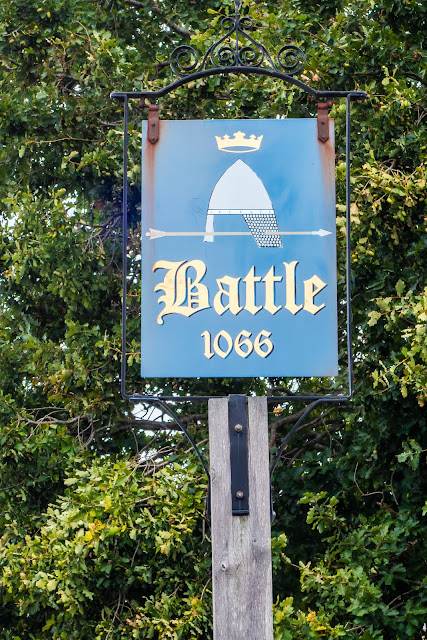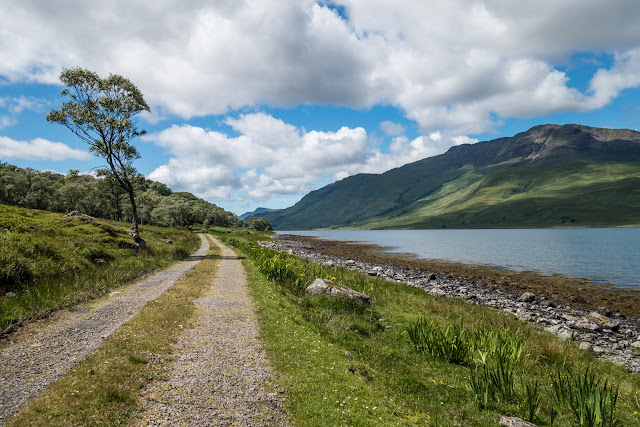The town of Battle, East Sussex
Many moons ago I was to learn that the famous battle did not take place in Hastings after all!. I am not sure at what age I came to this knowledge, but I remember thinking "Why call it the Battle of Hastings if it was fought some miles away?" The landing by the Duke of Normandy did not even take place there, but at Pevensey Bay! Ah well!
The location at Battle has been contested in recent years, but the arguments for alternative sites are extremely flimsy, whereas the evidence for the traditional site remains overwhelmingly strong.
Anyway, ` a must visit` was to the real site, at the town of Battle.
The town sign as we entered the main street.
The town Of Battle
At the top end of the town of Battle, stands the ruins of Battle Abbey. This image was taken of the High Street, with my back to the Abbey gates. Battle stands on a hill, with the abbey being built at the top. Remember, the Battle was fought in 1066 AD with Harold encamped on top of the hill looking down on the approaching Normans - a sensible battle tactic.
The Almonry
The Council owns the Almonry site which includes, as well as the Town Council offices, the Town Museum and a public garden.
We are told that a house has most likely been on the site of what is now known as The Almonry since 1090 when the town was first laid out. The first rental, dated about 1107, is in the Battle Abbey Chronicle, an account of the Battle and the founding of the Abbey which was written by the monks and is now housed in the British Library.
It never was an Almonry but the Almoner did own land behind the present Market site and Western Avenue. The house was known from the early Middle Ages as KNIGHT's taken from an important family which owned land in the Leuga - the one league radius round Battle which the Conqueror gave to his new Abbey.
Records show that the property was part of the Abbey Estate and had a number of tenants until it reverted to the Abbey in 1800. It was sold in about 1930 and remained in private ownership until the early 1980's when it was acquired by the County Council.
The present building is a good example of the type of oak framed timber house built after the years of decline following the black death and was originally a five bay hall house built in the C15. It has since been partially rebuilt, added to and some parts even demolished over the centuries. Most of these changes, including the addition of chimneys, took place in the C16 and C17. An unusual feature of the building is an internal courtyard which also has a well.
St Mary the Virgin
A large church, originally C12, with an early C13 nave. The chancel is a little later. The south aisle was remodelled in the C14 and the north aisle in the C15, when the present tower and chapels were added. There are wall paintings of c1300, fine monuments and brasses.
Commemorates the Battle of Hastings and is by M C F Bell, 1984

Painted stones seen in the churchyard. Photographed and replaced.
The Abbey Gatehouse
Still dominating the town, as it was intended to, is the great gatehouse of 1338 and its adjacent precinct wall. The crenellations, arrow slits and wall-walk make the gatehouse look very defensive. The abbot of Battle had important responsibilities for the defence of the Sussex coast, especially during the Hundred Years War (1337–1453). However, the gatehouse defence features would have been of little practical use and the building would not have been able to sustain a serious assault. Rather than being defensive, it is much more likely that the gatehouse had ceremonial and administrative functions. The monks would also have allegorised the building as the portal of the Heavenly Jerusalem.
The high south end of the east range of the abbey buildings reflects how difficult it was to provide a level floor for the dormitory on the first floor, because of the steep slope of the hillside on which King William insisted the abbey should be built
`Who` and `why` was it built? The Norman invasion and conquest of England had an explicit religious dimension. Norman authors stress that Harold was a perjurer – according to them, he had broken an oath, sworn on sacred relics in 1064, to support William’s claim to succeed Edward the Confessor, and usurped the English throne. Because of this, William gained church support for his invasion of England. Even Pope Alexander II gave the enterprise his sanction, enabling William to invade under a papal banner, promising to depose the sacrilegious Harold and reform the English church.
Yet despite this religious support, William and his supporters had imperilled the everlasting safety of their souls because of the violence of the conquest. Even by medieval standards the Battle of Hastings, and the subsequent suppression of English resistance, were exceptionally bloody. Founding an abbey was a way for William to atone for such terrible sins. Other victors had done so before him: Count Fulk Nerra of Anjou founded Loches Abbey after his victory over the Bretons at the Battle of Conquereuil in 992, and King Cnut established a memorial church on the site of the Battle of Assandun in 1016, where he had defeated Edmund II (Ironside) to take the English throne.
Several of William’s henchmen also founded monasteries. Fear of eternal damnation was undoubtedly behind the decision of Roger of Montgomery, Earl of Shrewsbury, to establish a Benedictine monastery in the town, and he also founded the Cluniac priory at Wenlock, Shropshire, in about 1080. William de Warenne, who fought at the Battle of Hastings, sought security in the afterlife by founding a priory near his castle at Castle Acre in Norfolk. Eudo, the Conqueror’s steward, founded Colchester Abbey in 1096.
Eight times a day the monks of Battle assembled in their church to sing the Divine Office. At each of these services, and at daily High Mass, the community would have remembered the Conqueror and all those who died at the battle – Norman and Saxon alike – in their prayers. Indeed, the abbey’s Chronicle states that the monastery was to be ‘a place of sanctuary and help for all, paying back for the blood shed there by an unending chain of good work.’
One of the remarkable vaulted ground-floor rooms below the dormitory in the east range, which gives an impression of the quality of all the buildings at Battle Abbey before they were ruined. This was probably the monks' common room
On the eastern side is the west range of the cloister, later adapted as a substantial residence by successive abbots, ensuring its survival as a country house after 1538. It is now a school.
Senlac hill or ridge, site of the famous battle.
Memorial statue in Battle
A metal structure described as a 1066 memorial statue erected on a roundabout at the northern end of the town of Battle. Created by Kent-based sculptor Guy Portelli, it was officially unveiled on 11 November 2016, Armistice Day. It depicts a mounted Norman being attacked by an Anglo-Saxon on foot reflecting the start of the Battle of Hastings which took place some 700 metres to the south on 14th October 1066.















Comments